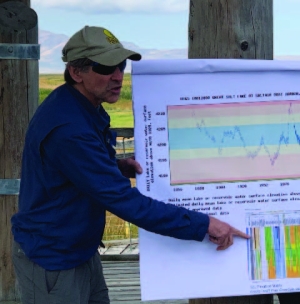Manager, Groundwater and Wetlands Program
Utah Geological Survey
Bio:
Hugh Hurlow manages the Utah Geological Survey’s Groundwater and Wetlands Program. Hurlow has worked at UGS since 1995 on a wide variety of projects and topics including hydrogeology, groundwater chemistry, geophysics, and watershed hydrology. Hurlow holds a Professional Geologist License and degrees in geological sciences from the University of Washington (Ph.D.), University of Wyoming (M.S.), and Brown University (Sc. B).
Title: Investigating Groundwater Inflows to Great Salt Lake
Abstract: This multidisciplinary, collaborative project aims to improve understanding of the mechanisms, locations, chemistry, and volume of groundwater inflows to Great Salt Lake (GSL). Existing estimates of groundwater inflows to GSL are essentially derived from water budget residuals (i.e., inflow needed to balance the overall GSL water budget), not direct measurements. Independent measurements of groundwater inflows are needed to verify and improve water budgets and to evaluate the complex interplay between lake water and groundwater in wetlands. Recent work, including groundwater modeling (Masbruch et al., 2016), stream chemistry (Godsey et al., 2009), streamflow modeling (Brooks et al., 2021), and stream hydrograph analysis (Wolf et al., 2023) indicated that groundwater inflow (both directly into GSL and into streams within the GSL watershed) was previously underestimated. In addition, a study of stream, spring, and lake water chemistries suggested groundwater accounts for ~ 10% of the GSL brine (Bunce, 2022); and a large-scale, GIS-based analysis of groundwater levels surrounding GSL estimated ~ 10% groundwater contribution to the total annual GSL water budget (Zamora and Inkenbrandt, 2024).
Our project includes installing monitoring wells along transects from the GSL margin to the playa; geochemical sampling and groundwater-level analyses; measuring vertical groundwater seepage to the land surface; geophysical surveys; and analyzing aerial imagery. Farmington Bay is our current primary focus area, but our study includes sites near Saltair, the very north end of Tooele Valley, and the west shore of Antelope Island to compare groundwater inflows in various hydrogeologic settings. To date we have (1) conducted seepage measurements of groundwater flow to the land surface in Farmington Bay, (2) cored sediment to as deep as 100 feet at five sites, (3) installed groundwater monitoring wells at four sites, and (4) measured pore water conductivity in two of the cores. Future work includes sampling and analyzing core pore water and well water for chemistry, installing long-term monitoring equipment, installing more wells, resistivity measurements, and investigating possible areas of diffuse groundwater inflow using small unmanned aircraft systems (sUAS)-collected thermal imagery and seepage meters.
Brooks, P. D., Gelderloos, A., Wolf, M. A., Jamison, L. R., Strong, C., Solomon, D. K., et al., 2021, Groundwater- mediated memory of past climate controls water yield in snowmelt- dominated catchments: Water Resources Research, v. 57, e2021WR030605. https:// doi.org/10.1029/2021WR030605.
Bunce, L.E., 2022, Significance of spring inflow to Great Salt Lake: M.S. Thesis, Binghamton, Binghamton University, 64 p.
Godsey, S.E., J.W. Kirchner, and D.W. Clow, 2009, Concentration – discharge relationships reflect chemostatic characteristics of US catchments: Hydrological Processes, p. 1844–1864.
Masbruch, M.D., C.A. Rumsey, S. Gangopadhyay, D.D. Susong, and T. Pruitt, 2016, Analyses of infrequent(quasi-decadal) large groundwater recharge events in the northern Great Basin—Their importance for groundwater availability, use, and management: Water Resources Research, v. 52, p. 7819–7836, doi:10.1002/2016WR019060.
Wolf, M., Jamison, L.R., Solomon, D.K., Strong, S., Brooks, P.D., 2023, Multi-year climatic controls on groundwater storage in seasonally snow-covered headwater catchments: Water Resources Research, v. 59, https://doi.org/10.1029/2022WR033394.
Zamora, H.A., and Inkenbrandt, P.I., 2024, Estimate of groundwater flow and salinity contribution to Great Salt Lake using groundwater levels and spatial analysis: Utah Geological Association Publication 51, p. 1–24 p.

